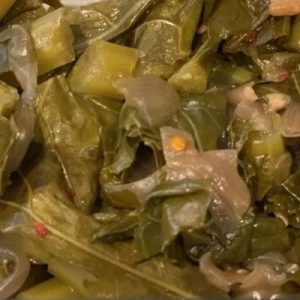Focus on Nutrition: Collard Greens
1 cup, cooked, boiled, & drained collard greens = 1 serving. RDA=Recommended Daily Allowance
extremely high in:
- vitamin K (836 mcg = 1045% RDA)
- vitamin A (15416 IU = 308% RDA)
- vitamin C, (34.6 mg = 58% RDA)
- folate, (177 mcg = 44% RDA)
- manganese (0.8 mg = 41% RDA)
- calcium (266 mg = 27%)
- Magnesium (38.0 mg = 27%)
Collard greens are a good vegetable source of fiber (5.3 g=21% RDA) AND a good vegetable source of protein (4.0 g = 8% RDA).
Folate
Folate (previously all folates and folic acid were reported as mcg folic acid.)
Dietary folate can come in both naturally occurring folates and synthetic folic acid.
New guidelines require that folates/folic acid be reported in Dietary Folate Equivalents (DFE) with mcg of folic acid in parentheses.
Folic acid has greater bioavailability than naturally occurring folates.
Conversion Factor:
- 1 mcg DFE = 1 mcg folates
- 1 mcg DFE = 0.6 mcg folic acid
Vitamin A
Vitamin A: has previously been reported in international units (IU)
Vitamin A in the diet can come in different forms:
- retinol,
- beta-carotene,
- alpha-carotene, and
- beta-cryptoxanthin.
Some of these forms have greater bioavailability than others.
New labeling guidelines require reporting of vitamin A in the unit of mcg RAE, (retinol activity equivalent)
accounts for the differing bioavailability of the forms.
Conversion Factors
Old:
- 1 IU = 0.3 mcg retinol
- 1 IU = 0.6 mcg beta-carotene.
New:
- 1 mcg RAE = 1 mcg retinol
- 1 mcg RAE = 2 mcg supplemental beta-carotene
- 1 mcg RAE = 12 mcg beta-carotene
- 1 mcg RAE = 24 mcg alpha-carotene
- 1 mcg RAE = 24 mcg beta-cryptoxanthin
Vitamin E
 Key nutrients (Daily Value)
Key nutrients (Daily Value)
- iron (12%)
- vitamin B2 (12%)
- vitamin B6 (12%)
- vitamin E (8%)
- phosphorus (6%)
- potassium (6%)
- vitamin B1 (5%)
- vitamin B3 (5%)
- copper (4%)
- vitamin B5 (4%)
- zinc (3%)
- selenium (1%)
- choline (<1%)
- betaine (<1%)
Helpful Tips:
 When buying collard greens:
When buying collard greens:
- Buy collard greens that are firm and have deep-green leaves
- Smaller leaves are more tender
- Smaller leaves have a milder flavor
- Store collard greens in the refrigerator.
- Only steam collard greens for about 10 minutes to help retain nutrients.
Versatility:
Use in:
- salads,
- wraps,
- sandwiches,
- casseroles,
- soups,
- smoothies,
Preparation:
- boiled,
- braised, or
- sautéed (Recipe idea: sauté fresh onions and garlic in extra-virgin olive oil, and then add collard greens until they become tender.
- Juicing (combine with other vegetables and fruits like apples, celery, & cucumber ).
- Avoid frying in lard or bacon fat or overcooking (can lead to a bitter and strong sulfur taste).
Risks and Precautions:
- choose organic collard greens as conventionally grown greens may be contaminated with organophosphate insecticides, which are highly toxic.
- Collard greens contain oxalates. In high levels, oxalates may interfere with mineral absorption and cause a problem for those with gallbladder issues.
- Collard greens have a high vitamin K content. Since Vitamin K plays a big role in blood clotting, people taking certain medications (blood thinners) should exercise caution. Please consult with your health care practitioner before making changes to your diet.)
- Bloating is also a common side effect of high-fiber foods such as collard greens.



